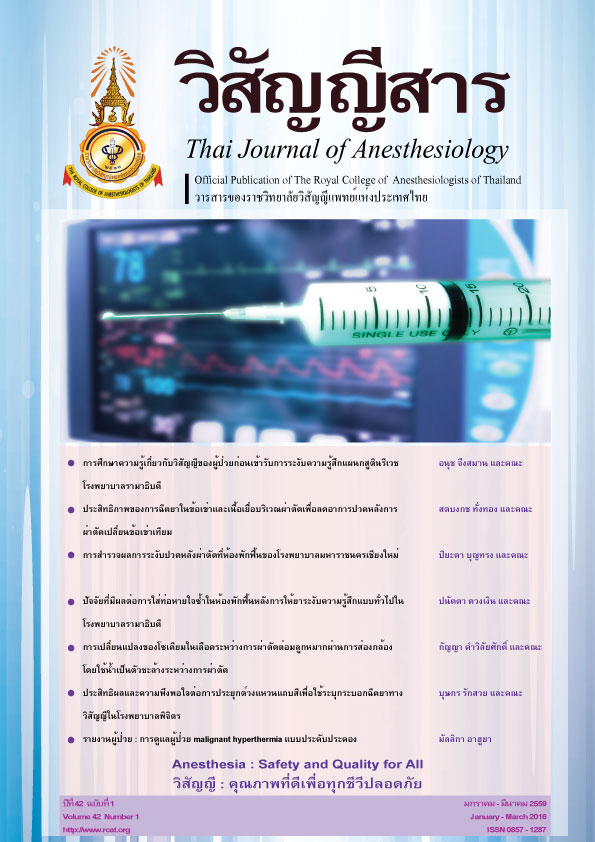Efficacy of local infiltration analgesia [LIA] for post operative pain relief after total knee arthroplasty [TKA].
Main Article Content
Abstract
Background: Postoperative pain after total knee arthroplasty [TKA] is often severe and difficult to manage. We investigated the efficacy of intraoperative local infiltration analgesia [LIA] to relieve postoperative pain after TKA. The LIA technique used was a peri-articular injection of combined long-acting local anesthesia, nonsteroidal anti-inflammatory drug, and adrenaline. We compared the efficacy in post operative TKA pain reduction of intrathecal morphine with and without LIA.
Methods: Forty patients undergoing elective TKA under spinal anesthesia with morphine 0.2 mg were randomly assigned to receive an intrathecal morphine alone or an intrathecal morphine with LIA. In group 1 [NSS]: NSS 120 ml were injected intra-articulary during the operation. In group 2 [KLA]: Levobupivacaine 2 mg/kg, ketorolac 30 mg, adrenaline 0.5 mg , NSS total volume 120 ml were injected intra-articularly during the operation. We recorded additional tramadol consumption for pain control and pain score in the first 24 postoperative hours.
Results: Mean tramadol consumption was significantly lower in group 2 [KLA] than group 1 [NSS] during first 24 postoperative hours : 37.50 ±27.50 vs 142.50 ± 43.76 mg. Less proportion of patients in group 2 [KLA] needed tramadol compared to group 1 [NSS] : 65 % vs 100%. Mean time to first dose tramadol request was significantly lower in group 1[NSS] than group 2 [KLA] : 154.25 ± 203.92 vs 1018.50 ± 383.63 mg. Mean pain score was significantly lower in group 2 [KLA] compared to group 1 [NSS] during first 24 postoperative hours. There were no differences in side effect, dose of metoclopamide, and chlorpheniramine used between two groups.
Conclusion: LIA technique provide excellent pain relief and low tramadol consumption after TKA.
ประสิทธิภาพของการฉีดยาในข้อเข่า และเนื้อเยื่อบริเวณผ่าตัด เพื่อลดอาการปวดหลังการผ่าตัดเปลี่ยนข้อเข่าเทียม
บทนำ: อาการปวดหลังการผ่าตัดเปลี่ยนข้อเข่าอยู่ในระดับปานกลางถึงรุนแรงมากทำให้มีการค้นคว้าวิธีการต่างๆ เพื่อมาลดอาการปวด ซึ่งมีการนำวิธีการ LIA ซึ่งเป็นวิธีการฉีดยาชาที่มีฤทธิ์นานร่วมกับยาnonsteroidal anti-inflammatory drugs (NSAIDs) และ adrenalineโดยฉีดบริเวณรอบข้อเข่าก่อนที่จะปิดแผลผ่าตัด มาใช้ในการระงับปวดหลังการผ่าตัดเปลี่ยนข้อเข่าเทียม โดยศึกษาเปรียบเทียบวิธีระงับความรู้สึกโดยฉีดยาชาร่วมกับมอร์ฟีนเข้าช่องน้ำไขสันหลังเพียงอย่างเดียวกับการฉีดยาบริเวณข้อเข่าร่วมกับวิธีระงับความรู้สึกโดยฉีดยาชาร่วมกับมอร์ฟีนเข้าช่องน้ำไขสันหลัง
วิธีการศึกษา: เป็นการศึกษาแบบ prospective randomized controlled trial โดยผู้ป่วย 40 คน ที่เข้ารับการผ่าตัดเปลี่ยนข้อเข่าตามตารางนัดหมาย ได้รับวิธีการระงับความรู้สึกโดยฉีดยาชาร่วมกับมอร์ฟีน 0.2 มิลลิกรัมเข้าช่องน้ำไขสันหลังแบ่งเป็น 2 กลุ่ม กลุ่มละ 20 คนโดยกลุ่มที่ 1 [NSS]: ได้รับการฉีด NSS 120 มิลลิลิตร บริเวณรอบข้อเข่า กลุ่มที่ 2 [KLA]: ได้รับการฉีดยาชาlevobupivacaine 2 มิลลิกรัม/กิโลกรัม, ยาแก้ปวด ketorolac 30 มิลลิกรัม, ยา adrenaline 0.5 มิลลิกรัม, NSSปริมาตรรวม 120 มิลลิลิตร บริเวณรอบข้อเข่า ทำการเก็บข้อมูลปริมาณยาแก้ปวดชนิด tramadol คะแนนความปวดหลังการผ่าตัดในเวลา 24 ชั่วโมง
ผลการศึกษา: ค่าเฉลี่ยของปริมาณยา tramadol หลังการผ่าตัด 24 ชั่วโมงแรกของผู้ป่วยในกลุ่มที่ 2 [KLA] น้อยกว่ากลุ่มที่ 1 [NSS] อย่างมีนัยสำคัญทางสถิติคือ 37.50 มิลลิกรัม และ 142.50 มิลลิกรัม ค่าเฉลี่ยเวลาที่ได้รับยาแก้ปวดครั้งแรกของกลุ่มที่ 1 [NSS] เร็วกว่า ในกลุ่มที่ 2 [KLA] อย่างมีนัยสำคัญทางสถิติคือ 154.25 นาที และ 1018.50 นาที ค่าเฉลี่ยคะแนนความปวดในช่วง 24 ชั่วโมงหลังการผ่าตัดของกลุ่มที่1 [NSS] มากกว่า ในกลุ่มที่ 2 [KLA] อย่างมีนัยสำคัญทางสถิติ แต่ไม่มีความแตกต่างกันในเรื่องอุบัติการณ์ของการคลื่นไส้และอาเจียน การคัน ปริมาณของยาแก้คลื่นไสและอาเจียน ยาแก้คัน ระหว่างผู้ป่วยทั้งสองกลุ่ม
สรุป: วิธีการ LIA สามารถลดปริมาณความต้องการยาแก้ปวด และระดับคะแนนความปวดได้ดีหลังการผ่าตัดเปลี่ยนข้อเข่าภายใน24 ชั่วโมงหลังการผ่าตัด


